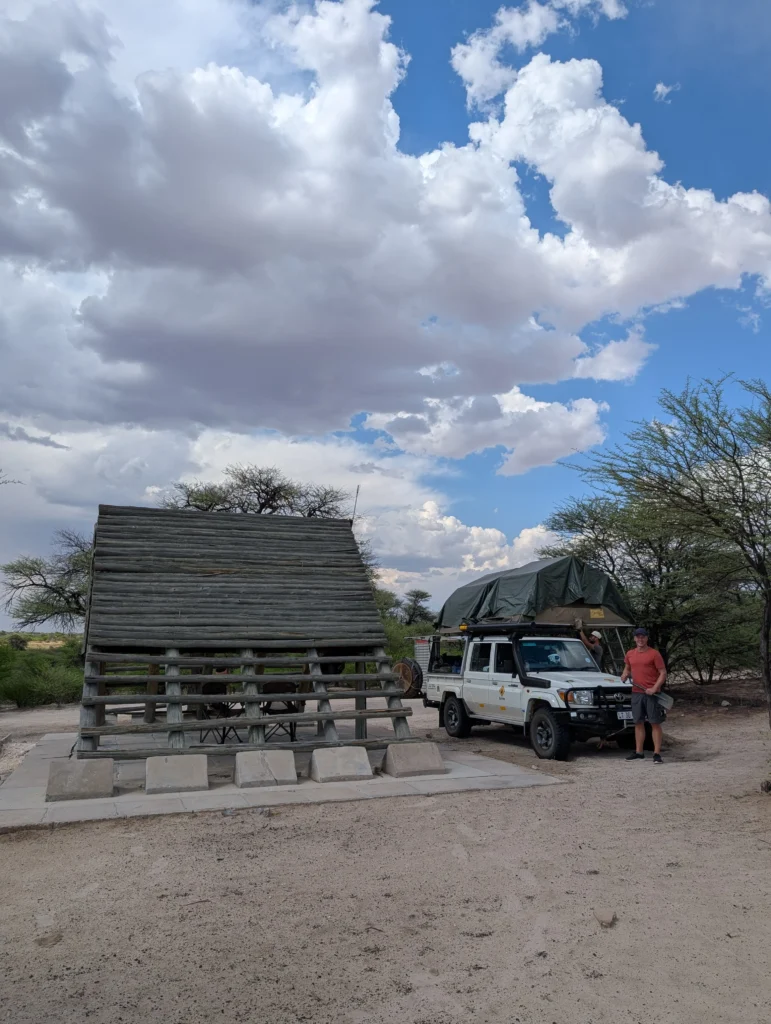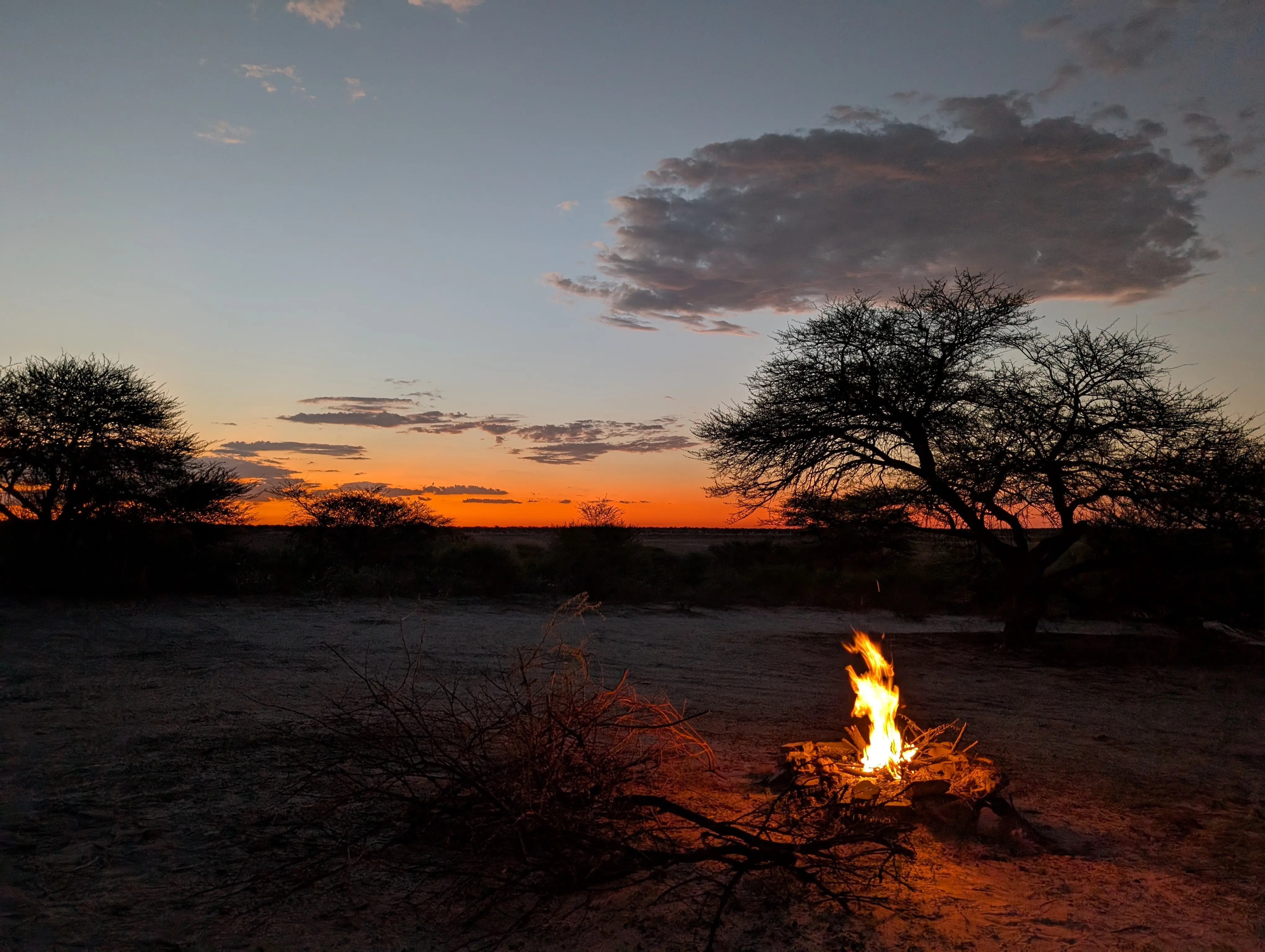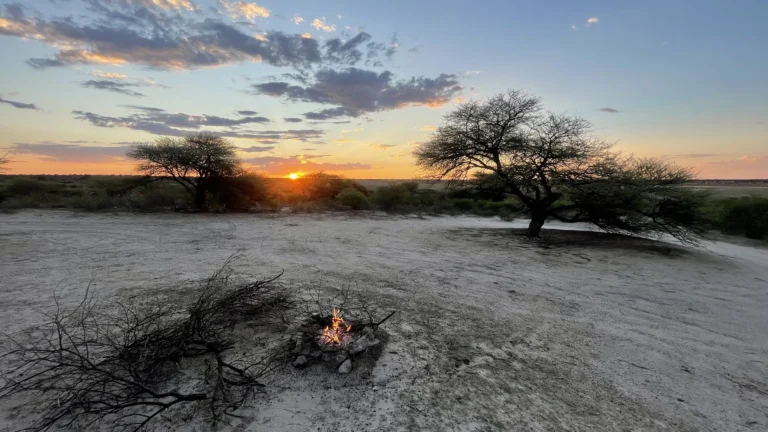On This Page

Introduction: A Strategic Base in the Mabuasehube Wilderness
I’ve learned that choosing a campsite is a strategic decision, not just a logistical one. In the wild Mabuasehube section of the Kgalagadi, your choice of pan can define your entire experience. While some sites are famous for non-stop predator action, Khiding Campsite – Kgalagadi Transfrontier Park offers something different: a perfect balance of solitude, accessibility, and authentic wilderness.
This guide is a systems-level breakdown of Khiding Campsite. We’ll analyze its pros and cons compared to its more famous neighbors, detail the on-the-ground reality of its facilities, and provide a clear, actionable plan for booking and visiting. This isn’t just a review; it’s the operational manual you need to successfully execute a trip to this incredible corner of the Kalahari.
Khiding vs. Other Mabuasehube Pans: A Strategic Comparison
Choosing a pan in Mabuasehube is a trade-off between solitude and the probability of lion sightings. I’ve broken down the key variables to help you decide if Khiding is the right system for your goals.
| Feature | Khiding Pan | Mpayathutlwa & Lesholoago Pans | Monamodi & Bosobogolo Pans |
|---|---|---|---|
| Lion Reputation | Good. Lions are known to pass through, but it’s not the territory of a dominant, resident pride. | Legendary. These are the most famous lion hotspots, with resident prides often seen at the waterholes. | Fair. Less frequented by lions than the main pans, offering a more tranquil experience. |
| Sense of Solitude | Excellent. With only two campsites, it feels very private and remote. | Good, but can be busy. These are the most popular pans, so you’re more likely to have neighbors. | Exceptional. These pans are quieter and see far less traffic. |
| Facilities | A-frame shelter, pit latrine, braai pit. No shower structure. | A-frame shelter, pit latrine, basic shower enclosure (bring your own bucket). | Varies, but generally just a pit latrine and braai pit. |
| Verdict | The perfect balanced choice for a first-timer or someone wanting a guaranteed wild feel without the crowds. | The best choice if your single-minded goal is to maximize your chances of seeing lions. | The best choice for those seeking absolute solitude and a focus on the broader desert ecosystem. |

The On-the-Ground System: What to Expect at Khiding Campsite
The beauty of Khiding lies in its simplicity. It’s designed to give you a foothold in the wilderness, nothing more. Understanding the components of the campsite is key to a comfortable stay.
The Campsite Layout and A-Frame Shelter
Khiding Pan has two designated campsites, KHI01 and KHI02, which are well-spaced for privacy. The main feature of each site is a simple, three-sided A-frame shelter. This is not for sleeping in; its purpose is to provide a patch of reliable shade during the harsh midday sun—a critical asset in the Kalahari. It’s the perfect place to set up your camp kitchen and chairs.
Ablutions: The Pit Latrine and Bucket Shower
Each site has a dedicated pit latrine (long drop toilet) enclosed by a small wooden structure for privacy. There is no flushing toilet and no running water. Crucially, Khiding does not have a dedicated shower enclosure. If you want to wash, you must bring your own shower bucket and hang it from a tree. This is a key difference from sites like Mpayathutlwa.
The Water Situation: There Is None
The first rule of any Kalahari trip is ‘pack redundancy.’ For our stay at Khiding, we calculated 5 liters of water per person per day, then added a 25-liter emergency container. We ended up using almost all of it. The dry air and heat are relentless. You cannot bring too much water. There is actually water in Khiding Camp but obviously only to cleanup stuff and not to drink. It is supplied from a reservoir. Every drop you need for drinking, cooking, and washing must be brought with you.
A Step-by-Step Guide to Booking Khiding Campsite
Booking a Botswana Parks (DWNP) campsite is a notorious challenge, but it’s a solvable problem with a systematic approach. As this was a key stop on our 18-day overland safari, getting the booking right was critical.
- Plan 11 Months Out: DWNP bookings open 11 months in advance. For popular sites, you need to be ready on day one.
- Contact DWNP Directly: The official method is to email the DWNP reservations office with your name, desired dates, park (Mabuasehube), and a list of preferred campsites (e.g., “1st choice: KHI01, 2nd choice: KHI02”). The address is dwnp@gov.bw. Be prepared for a slow, multi-email process.
- Consider a Booking Agent: This is my recommended path. For a nominal fee, companies in Botswana can handle the entire frustrating process for you. It’s a small price to pay for a guaranteed booking without the headache.
- Pay and Print: Once you receive a tentative booking, you will need to pay via bank transfer. After payment, you’ll receive a final confirmation voucher. You must print this voucher and present it at the Mabuasehube gate. No voucher, no entry.

Critical System Errors: Common Mistakes to Avoid
- Forgetting a Shower Bucket: Many travelers assume all Mabuasehube sites have a shower enclosure. Khiding does not. Forgetting your own shower bag means you won’t be washing.
- Underestimating the Drive: The track from the main Mabuasehube gate to Khiding Pan is sandy and can take over an hour, even though it’s a short distance. Deflate your tyres and allow plenty of time.
- Having “Lion Tunnel Vision”: Don’t just sit in camp waiting for lions. Khiding is fantastic for spotting other Kalahari specialists like brown hyenas, bat-eared foxes, and herds of gemsbok. Explore the surrounding tracks at dawn and dusk.
- Ignoring the Wind: The A-frame is great for sun, but it can act like a sail in the wind. Position your vehicle to create a windbreak for your fire and cooking area.
Conclusion: The Verdict on Khiding Campsite
So, is Khiding Campsite in the Kgalagadi Transfrontier Park the right choice for you? If you are a first-time visitor to Mabuasehube, I believe it is the perfect introduction. It guarantees an authentic, unfenced wilderness experience and a wonderful sense of isolation without the potential crowds of the more famous pans.
It may not have the celebrity lion prides of its neighbors, but it offers a more balanced and peaceful immersion into the Kalahari. It’s a place that rewards the well-prepared traveler with profound silence and the thrill of the unexpected. It’s less of a spectacle and more of a conversation with the desert.
Frequently Asked Questions
How many campsites are at Khiding Pan?
There are only two designated campsites at Khiding Pan: KHI01 and KHI02. They are located on opposite sides of the pan, providing excellent privacy and a real sense of solitude for campers.
Is there a waterhole at Khiding Campsite?
No, there is no artificial or pumped waterhole at Khiding Pan itself. This is why it tends to be quieter than pans like Mpayathutlwa or Lesholoago. Wildlife sightings are based on animals moving through the area and grazing on the pan, rather than being drawn to a single water source.
How far is Khiding from the Mabuasehube gate?
Khiding Pan is one of the closest pans to the main Mabuasehube gate. The distance is approximately 11 kilometers (about 7 miles). However, due to the deep sandy tracks, you should plan for the drive to take between 45 minutes to an hour.


